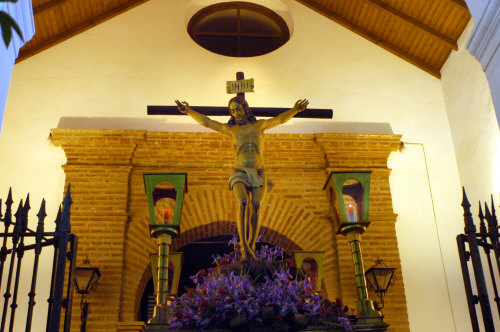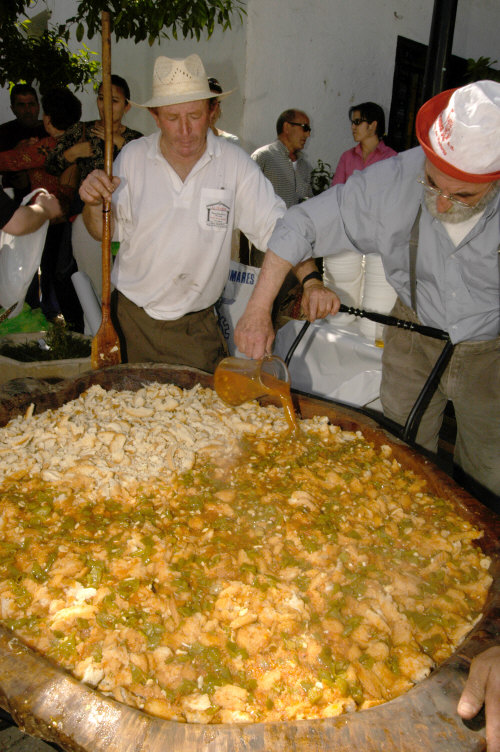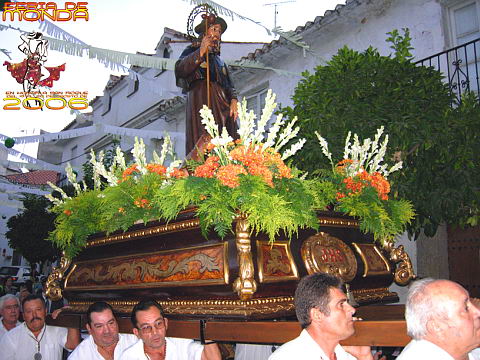|

MONDA - FIESTAS
CARNIVAL. Last
weekend of February
The festive calendar of Monda begins with
the Carnival. On these days the streets of
Monda fill with merrymaking and joy. A
festival of pagan origin in which the
colourful murgas and chirigotas satyrise
events that have happened during the year.
The fancy dress contest and the competition
for the best comparsa (carnival groups) mean
that the costumes are more and more original
every year.
EASTER WEEK.
Depending on the Christian calendar
Shortly after, as for every year over the
last three centuries, Easter Week is
celebrated with the most fervent details.
During this week the passion of Christ is
commemorated, reflected in the processions
of the penitent brotherhoods. The
brotherhoods are composed of ‘Nazarenes’,
penitents who accompany the religious
statues, dressed in tunics and hoods.
Normally the procession takes place in two
“passes”, the first representing the passion
and death of Christ, and the second in which
the statue of de Virgin Mary is carried, her
face reflecting sorrow and hope. There are
brotherhoods of silence and others that
parade accompanied by music The honour
passes from fathers to sons for carrying the
religious floats through the narrow streets
lined with flower-filled balconies,
constantly accompanied by the steps of the
float-bearers which are interrupted only by
the beautiful “saetas” (sacred songs) that
are sung as it passes by. Worthy of mention
is the Via Crucis to the Calvary that is
made on Easter Thursday, and the moment when
the Señor de los Azotes (the Whipped
Christ), Jesús Nazareno (Jesus of Nazareth)
and the Virgen de los Dolores (Virgin of
Sorrows) are taken out of the church.


DAY OF MONDA SOUP.
March
The pretensions of an indigenous product or
a specifically traditional dish has resulted
over the last few decades in one of the most
popular fiestas in a number of villages in
which these celebrations, without lessening
the value of other much more traditional
fiestas, have become strongly established as
the best tourist attraction. With the
arrival of spring, Monda celebrates the Day
of the Monda Soup or ‘poncima’ soup. A
giant-size wooden bowl, very typical in
these mountain villages, is filled with
bread which, later, will be moistened with a
typical broth made from fried vegetable
mixture (peppers, “hanging” tomatoes,
garlic, oil) and eggs. The fiesta is held on
a Sunday (the date varies) in March, in a
grand lunch with participation of old and
young, all making their soups in the village
square, and to which any visitors are
invited to sample and enjoy.



MONDA CULTURAL
FESTIVAL. June and July
A series of cultural events and competitions
of different kinds are held during the
months of June and July. It starts at the
beginning of June with the Painting Day,
when painters come to Monda and, for a
number of hours, paint any picturesque
corner of the village, and their works are
then displayed in the cellars beneath the
Town Hall.
Then, in July, the Flamenco Song Competition
and the Cultural Week are held, when
theatre, lectures and even rock concerts are
the focus of attention for people of all
ages. Finally, there are two competitions
that are deeply rooted in the tradition and
folklore of Andalusia: the Regional Dance
Competition and the Spanish Song Competition.
FAIR OF SAN ROQUE.
From 15th to 18th August
These dates are days of merriment for all
the villagers. The Square, overflowing with
colour, welcomes everyone with dancing and
music. The Fair starts with the traditional
“diana floreada” (a tune announcing the
commencement of festivities) and rockets set
off from the Town Hall. During the fair
time, various events are organised, such as
horse shows, competitions and concerts,
street parades of giants’ heads, and also a
sampling of Monda-style gazpacho.



SHEPHERDS
COMPETITION. Weekend before Christmas
This event is a demonstration of one of the
most traditional musical events of the
district of Malaga. On this day, half a
dozen “shepherds” come to Monda to sing a
wide repertoire of traditional Spanish
Christmas carols, accompanied by the typical
sounds of strings of bells, “zambombas” (a
kind of rustic drum), a mortar, a bottle of
anisette and other home-made instruments
decorated with ribbons.
|